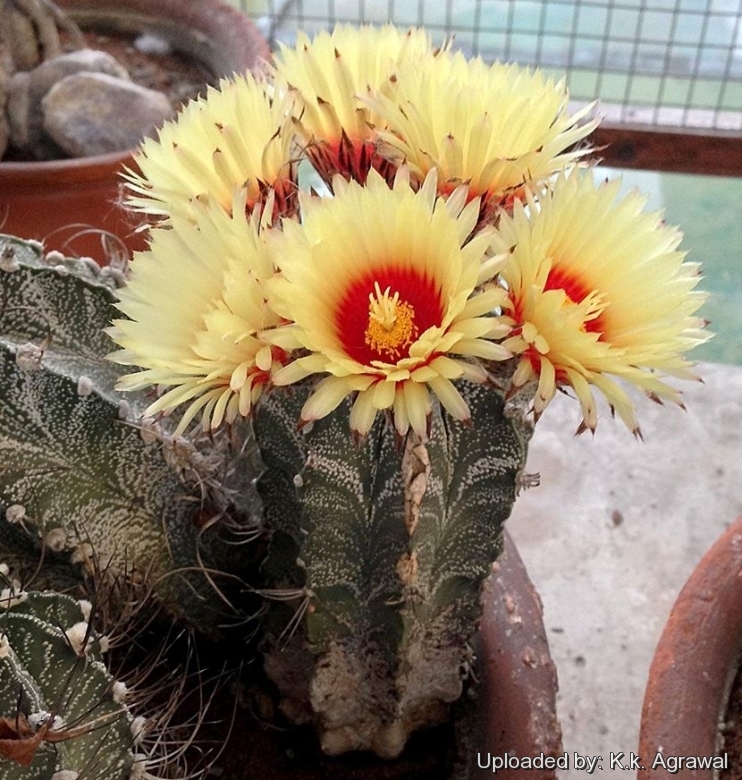
Astrophytum capricorne Photo by: K.k. Agrawal
Origin and Habitat: Northern Mexico (Coahuila) widespread in the
Chihuahuan Desert.
Synonyms:
See all synonyms of Astrophytum capricorne
Common Names include:
ENGLISH: Goat's Horns Cactus
GERMAN (Deutsch): Bischofsmütze, Bockshornkaktus
JAPANESE (日本語): taiho-gyoku (v. crassispinum), oho-gyoku (v. aureum), yokaku-gyoku, yokaku-gyoku, ziu-ho-gyoku, ho-o-maru (v. minus), ho-o-gyoku (v. minus), haku-ziuko-gyoku, yusei-taiho-gyoku (v. crassispinum)
RUSSIAN (Русский): Астрофитум козерогий
SPANISH (Español): Biznaga de estropajo (carrot-like vegetable sponge)
Description: Solitary globose or columnar cactus.
Stem: Although young plants are globular, they soon become ovoid, and eventually columnar up to 1.2 m tall, 10 (15) cm in diameter. The epidermis of is more or less covered with the typical white woolly flecks characteristic of the genus.
Ribs: Usually 8.
Areoles: In vertical rows along each rib and
Spines: 5 to 10 up to 7 cm long, Grey to brown wired, twisted, curved, flattened that look like the horn of a Capricorn. As plant ages spines get a bit more intense and messier, but relatively sparse, they are stiff but pliable and fragile, so, plant should be handled with care.
Flowers: Sweet smelling 7.5 cm wide, yellow with a red center.
Blooming season: Blooms in summer.
Fruit: Reddish covered with flattened spines, 2.5 cm in diameter.
Camouflage: The fine spines of this species are an optical artifice supporting the grass-mimicry to the surroundings.
Subspecies, varieties, forms and cultivars of plants belonging to the Astrophytum capricorne group
 Astrophytum capricorne F.A.C.Weber in Bois: Solitary globose or columnar cactus with long, curled and spines that looks like goat's horns.
Astrophytum capricorne F.A.C.Weber in Bois: Solitary globose or columnar cactus with long, curled and spines that looks like goat's horns. Astrophytum capricorne var. aureum Megata: The spines are golden yellow when young, but as they age become greyish like in the other capricorne.
Astrophytum capricorne var. aureum Megata: The spines are golden yellow when young, but as they age become greyish like in the other capricorne.- Astrophytum capricorne var. crassispinum nudum (H.Moeller) Y.Itô: The stems is larger bright green and almost bare (lack white dots). Spines arestriking strong and up to 8.5 cm long, flat, black to brown, or (occasionally white or yellow) in the youth, later grey-chalky.
 Astrophytum capricorne var. crassispinum (H.Moeller) Y.Okomura: Beautiful variety with striking strong flat and large spines up to 8.5 cm long. It is very similar to Astrophytum capricorne var niveum (and the differences between this variety is questionable)
Astrophytum capricorne var. crassispinum (H.Moeller) Y.Okomura: Beautiful variety with striking strong flat and large spines up to 8.5 cm long. It is very similar to Astrophytum capricorne var niveum (and the differences between this variety is questionable) Astrophytum capricorne var. crassispinum f. cristata hort.: crested form with strong, long, flat and large spines.
Astrophytum capricorne var. crassispinum f. cristata hort.: crested form with strong, long, flat and large spines.  Astrophytum capricorne var. crassispinum cv. Hooks: This is a rare form with spines ending with a hook.
Astrophytum capricorne var. crassispinum cv. Hooks: This is a rare form with spines ending with a hook.- Astrophytum capricorne var. crassispinum cv. Kigan: (cv. Kigan Gyoku) monstrous form loosing frequently its apical dominance with irregular shaped stems..
 Astrophytum capricorne var. crassispinum cv. Taiho-gyoku Megata: (cv. Taiho Gyoku) has few but stout, very wide and flatt spines.
Astrophytum capricorne var. crassispinum cv. Taiho-gyoku Megata: (cv. Taiho Gyoku) has few but stout, very wide and flatt spines.- Astrophytum capricorne var. mayor Frič: Larger form when living in open fields but very similar to standard Astrophytum capricorne (and the differences between this two forms is questionable)
 Astrophytum capricorne var. minus C.Runge & Quehl: (ho-o-gyoku, ho-o-maru) Small growing variety of the species when living in open fields.
Astrophytum capricorne var. minus C.Runge & Quehl: (ho-o-gyoku, ho-o-maru) Small growing variety of the species when living in open fields. Astrophytum capricorne var. niveum Y.Okomura: (cv. Hakuzuiho Gyoku) This form has striking more rigid and wide thorns and very more closely whiter flockingIt, it is bigger than var. senilis and aureum, and its dimension are similar to the standard species.
Astrophytum capricorne var. niveum Y.Okomura: (cv. Hakuzuiho Gyoku) This form has striking more rigid and wide thorns and very more closely whiter flockingIt, it is bigger than var. senilis and aureum, and its dimension are similar to the standard species.- Astrophytum capricorne f. nudum
 Astrophytum capricorne subs. senile (Frič) Doweld: It has dark reddish brown till black coloring spines, soon getting grey, bristly, flexible, square in cross-section, up to 10 cm long and pointing in all directions that often form up spirals, they are so densely nest wrapped that the body is hardly visible and looks like a dry grass bundle.
Astrophytum capricorne subs. senile (Frič) Doweld: It has dark reddish brown till black coloring spines, soon getting grey, bristly, flexible, square in cross-section, up to 10 cm long and pointing in all directions that often form up spirals, they are so densely nest wrapped that the body is hardly visible and looks like a dry grass bundle. Astrophytum capricorne subs. senile cv. Krausii: has pure white spines and a yellow flower but without the typical red throat.
Astrophytum capricorne subs. senile cv. Krausii: has pure white spines and a yellow flower but without the typical red throat. Astrophytum capricorne subs. senile cv. Rosa: ( cv. Pink Flowers) This is a selected form with Orangish or pinkish flowers with a red centre.
Astrophytum capricorne subs. senile cv. Rosa: ( cv. Pink Flowers) This is a selected form with Orangish or pinkish flowers with a red centre.- Astrophytum capricorne cv. Backebergi
 Astrophytum capricorne cv. Crassispinoides
Astrophytum capricorne cv. Crassispinoides- Astrophytum capricorne cv. Kiho-gyoku: (= Kihou Gyoku) like A. capricorne v. crassispinum but with yellow spines.
- Astrophytum capricorne cv. Snowfrec: has a greater density of white spots.
Notes: Astrophytum capricorneSN|3564]]SN|3564]] was described at the year 1851 from Dr. Albert DIETRICH as Echinocatus capricornis. In 1922 BRITTON and ROSE recombined this genus to Astrophytum.
Bibliography: Major references and further lectures
1) Edward Anderson “The Cactus family” Timber Press, Incorporated, 2001
2) James Cullen, Sabina G. Knees, H. Suzanne Cubey "The European Garden Flora Flowering Plants: A Manual for the Identification of Plants Cultivated in Europe, Both Out-of-Doors and Under Glass" Cambridge University Press, 11/Aug/2011
3) David R Hunt; Nigel P Taylor; Graham Charles; International Cactaceae Systematics Group. "The New Cactus Lexicon" dh books, 2006Jackie M. Poole, William R. Carr, Dana M. Price, Jason R. Singhurst “Rare plants of Texas: a field guide” Texas A&M University Press, 30/Dec/2007
4) Hiroshi Hirao “Colour encyclopaedia of cacti” Seibundo Shinkosha, 1979
5) Hans Hecht “BLV-Handbuch der Kakteen” BLV-Verlagsgesellschaft, 1982
6) Willy Cullmann, Erich Götz (Dozent Dr.), Gerhard Gröner “The encyclopedia of cacti” Timber Press, 1987
 Astrophytum capricorne Photo by: K.k. Agrawal
Astrophytum capricorne Photo by: K.k. Agrawal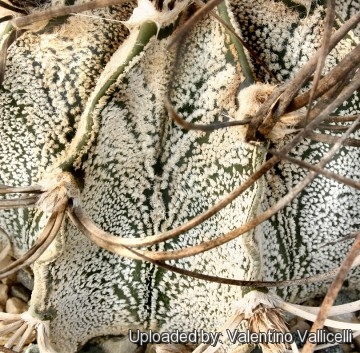 A plant (Locality: Parras) showing the characteristic hairy scales Photo by: Valentino Vallicelli
A plant (Locality: Parras) showing the characteristic hairy scales Photo by: Valentino Vallicelli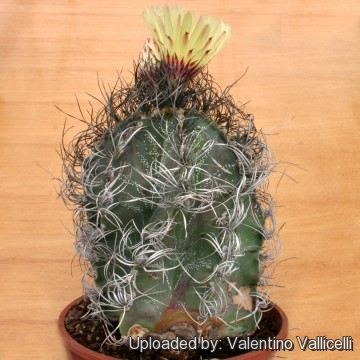 Astrophytum capricorne, a 25 years old specimen. Photo by: Valentino Vallicelli
Astrophytum capricorne, a 25 years old specimen. Photo by: Valentino Vallicelli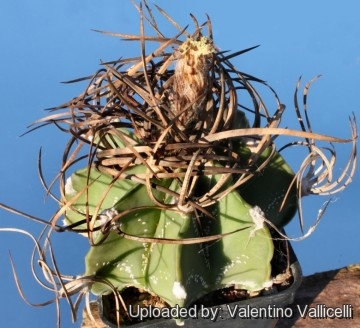 Astrophytum capricorne (Goat's Horns Cactus) Photo by: Valentino Vallicelli
Astrophytum capricorne (Goat's Horns Cactus) Photo by: Valentino Vallicelli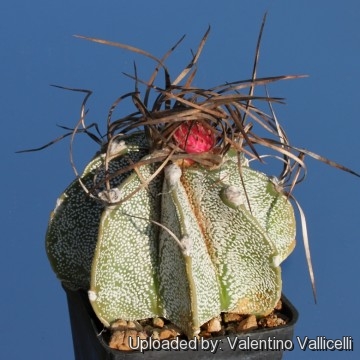 Astrophytum capricorne Photo by: Valentino Vallicelli
Astrophytum capricorne Photo by: Valentino Vallicelli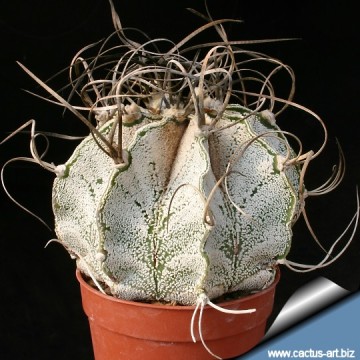 Astrophytum capricorne Photo by: Cactus Art
Astrophytum capricorne Photo by: Cactus Art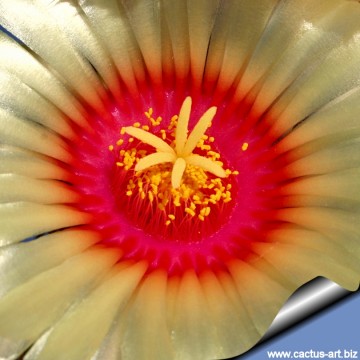 Astrophytum capricorne Photo by: Cactus Art
Astrophytum capricorne Photo by: Cactus Art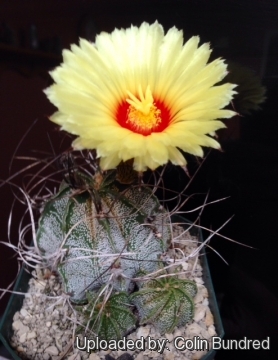 A 12 year old seed grown plant in my collection. Unusual in that it has started to cluster. Photo by: Colin Bundred
A 12 year old seed grown plant in my collection. Unusual in that it has started to cluster. Photo by: Colin BundredCultivation and Propagation: It is a popular summer-growing species of relatively easy cultivation.
Growth rate: Slow-growing.
Soil: Grow it in an open standard, sandy-gritty cactus compost and provide a very good drainage.
Exposure: It is suited for sunny-brightly exposure, but can tolerate light shade. However it will do its best with lots of sun and become stressed with inadequate light which could result in poor growth and unnatural shape. It has a good heat tolerance.
Watering: Water regularly (about once a week) during the growing season and keep it completely dry during winter or when night temperatures remain below 10° C. Water it less than average if in bigger pots.
Fertilization: Feed them once during the growing season with a fertilizer specifically formulated for cactus and succulents (high potash fertilizer with a dilute low nitrogen), including all micro nutrients and trace elements diluted to ½ the strength recommended on the label. They thrive in poor soils and need a limited supplies of fertilizer to avoid the plants developing excess vegetation, which is easily attacked by fungal diseases.
Special need: It is suited for airy exposures. Provide very good ventilation. Nearly all problems occur as a result of overwatering and poor ventilation, especially when weather conditions are dull and cool or very humid. ere.
Hardiness: It likes warmth (recommended minimum winter temperature 5° C) But plants kept perfectly dry can easily survive to light frost (it is reported hardy to -9 ° C for brief periods).
Pests & diseases: These cacti may be attractive to a variety of insects, but plants in good condition should be nearly pest-free, particularly if they are grown in a mineral potting-mix, with good exposure and ventilation. Nonetheless, there are several pests to watch for:
- Red spiders: Red spiders may be effectively rubbed up by misting the plants from above.
- Mealy bugs: Mealy bugs occasionally develop aerial into the new leaves and flowers with disfiguring results, but the worst types develop underground on the roots and are invisible except by their effects.
- Scales, thrips and aphids: These insects are rarely a problem.
- Rot: Rot is only a minor problem if the plants are watered and “aired” correctly. If they are not, fungicides won't help all that much.
Propagation: It can be propagated easily from seed (seldom produces offsets). The seeds can be sown in pots of fine, well-drained sandy soil, any time during the spring when temperatures are warm. Cover the seeds with a fine layer of grit and water from below with a fungicide to prevent damping off. For the 1-2 weeks cover the pots with a sheet of glass/clear perspex to keep the humidity levels high. Remove the glass and replace it with light shade-cloth and mist once or twice a day for the next two weeks after which most seeds should have germinated. From then on mistings can be reduced to every second and then every third day as the little plants grow. The seedlings should not be disturbed until they are well rooted after which they can be planted separately in small pots. Sometimes it is grafted to avoid root rot problems as plants grafted on an hardy stock are easy to grow and no special skill is required.
Your Photos
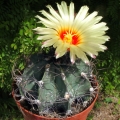
by Valentino Vallicelli
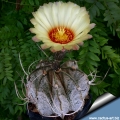
by Cactus Art
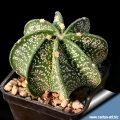
by Cactus Art

by Valentino Vallicelli

by Cactus Art























